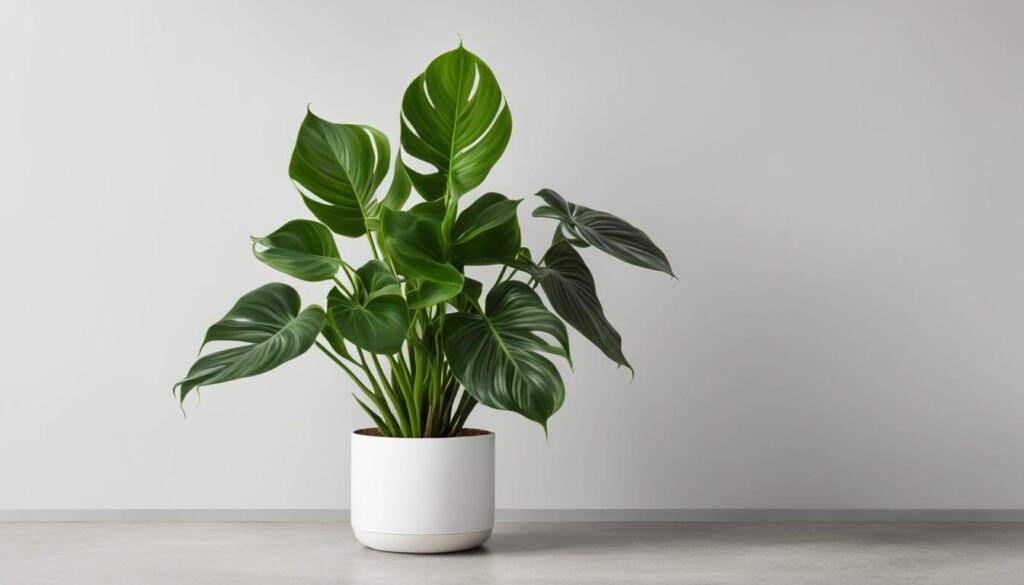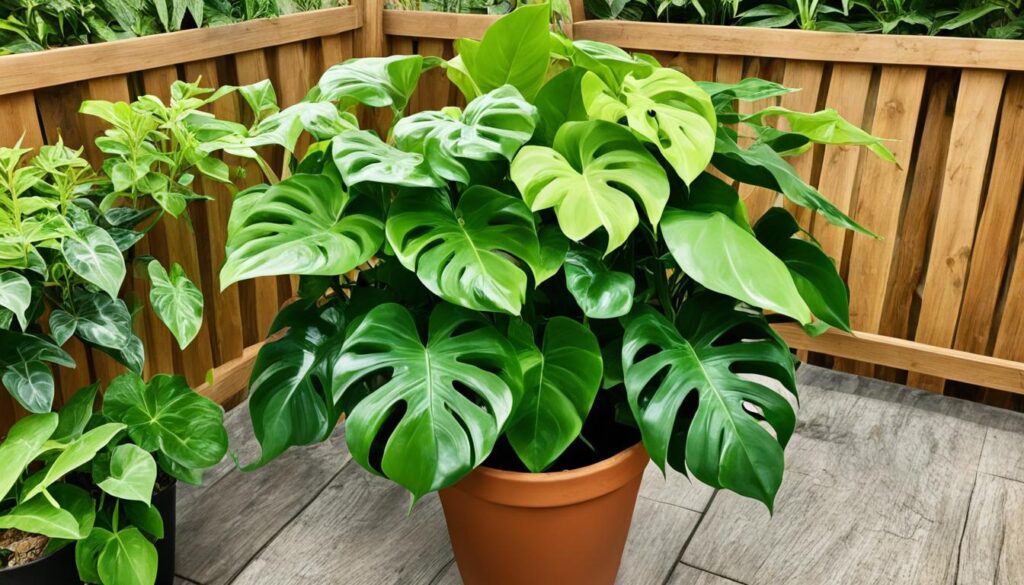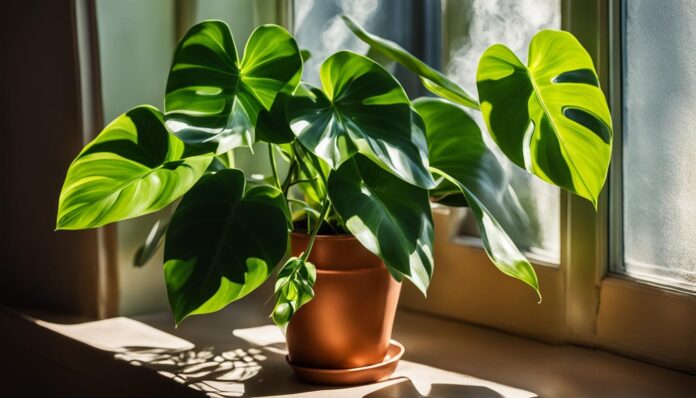Welcome to our comprehensive guide on caring for philodendrons, the perfect addition to your indoor plant collection. Whether you’re a seasoned plant enthusiast or just starting out, philodendrons are an excellent choice for any home or office space. With their vibrant foliage and low-maintenance nature, these tropical plants can thrive in a variety of conditions. In this guide, we’ll cover everything you need to know to keep your philodendrons happy and healthy.
Philodendrons are known for their beautiful, large, green, and glossy leaves that add a touch of tropical flair to any indoor space. They are part of the Araceae family and come in two main types: vining varieties and non-climbing varieties. While vining philodendrons like to climb on support structures, non-climbing varieties are perfect for containers.
To ensure your philodendrons flourish, it’s important to create the perfect growing environment that mimics their natural tropical habitat. This includes providing bright indirect light, loose acidic potting soil with good drainage, and moderate humidity levels. Proper watering, fertilizing, and regular repotting are also crucial for their overall health and growth.
In this guide, we’ll dive into the various philodendron varieties, including popular types like Philodendron scandens, Philodendron erubescens, Philodendron melanochrysum, Philodendron bipinnatifidum, and Philodendron ‘Birkin’. We’ll explore propagation methods, outdoor care, and even provide tips on distinguishing philodendrons from pothos plants.
So, whether you’re a plant lover looking to expand your collection or a beginner seeking a fuss-free plant to brighten up your space, our philodendron care guide has got you covered. With our expert tips and insights, you’ll be able to create a thriving indoor environment for your philodendrons and enjoy their beauty and benefits for years to come.
Key Takeaways
- Philodendrons are easy-to-grow indoor plants known for their beautiful, tropical foliage.
- Provide bright indirect light, well-draining soil, and moderate humidity for optimal philodendron growth.
- Water when the top inch of soil is dry and avoid overwatering.
- Fertilize monthly in spring and summer, and every 6 to 8 weeks in fall and winter.
- Repot philodendrons when the roots start growing out of the drainage holes.
The Beauty of Philodendron Foliage Plants
Philodendrons belong to the Araceae family and are known for their beautiful, large, green, and glossy leaves. They add a touch of tropical flair to any indoor space. There are two types of philodendrons: vining and non-climbing. Vining varieties like to climb on support structures, while non-climbing varieties are great for containers. Philodendrons have a fast growth rate and are excellent air purifying plants.
These plants are admired for their stunning foliage, making them popular choices for interior decoration. The lush leaves of philodendrons create a lush and vibrant atmosphere, transforming any room into a tropical paradise.
Philodendron foliage plants come in various shapes, sizes, and patterns, providing a wide range of options to suit different preferences and design schemes. From heart-shaped leaves to deeply lobed varieties, each type of philodendron showcases unique characteristics that add interest and visual appeal to your living spaces.
| Philodendron Variety | Description |
|---|---|
| Philodendron scandens | A popular climber with heart-shaped leaves. |
| Philodendron erubescens | A vigorous climber with reddish stems and leaves, including the ‘Pink Princess’ variety with pink variegation. |
| Philodendron melanochrysum | A stunning climber with dark, velvety leaves. |
| Philodendron bipinnatifidum | A large plant with deeply lobed leaves, also known as lacy tree philodendron. |
| Philodendron ‘Birkin’ | A variety with thin white stripes on green leaves, also called white wave philodendron. |
Whether you prefer the classic heart-shaped leaves or the unique variegated patterns, philodendron foliage plants provide endless possibilities for enhancing the aesthetics of your indoor spaces.
Aside from their ornamental value, philodendrons offer several benefits as houseplants. Their dense foliage helps purify the air by filtering out toxins, making them a natural choice for improving indoor air quality. In addition, their fast growth rate allows for quick and lush greenery, creating a calming and soothing environment.
“The rich foliage of philodendron plants brings the beauty and freshness of the tropics right inside your home.”
With proper care, including adequate light, water, and appropriate potting soil, you can enjoy the remarkable beauty of philodendron foliage plants and add a touch of tropical paradise to your indoor spaces.
Creating the Perfect Growing Environment for Philodendrons
To keep your philodendron healthy, it’s important to create an environment that mimics its natural tropical habitat. By providing the right conditions, you can ensure optimal growth and thriving foliage. Here are some essential factors to consider:
- Light: Philodendrons thrive in bright, indirect light. Place your plant near a sunny window where it can receive ample light throughout the day. However, be cautious of direct sunlight, as it can scorch the leaves. The ideal balance is to provide warmth and brightness without exposing the plant to intense rays.
- Soil: Use loose, acidic potting soil with good drainage for your philodendron. This type of soil allows for proper airflow and prevents waterlogging, which can lead to root rot. The pH level should be slightly acidic, around 5.5 to 6.5, to mimic the natural environment of philodendrons.
- Watering: Water your philodendron when the top inch of soil feels dry to the touch. Overwatering can be detrimental to the plant’s health, so it’s crucial to avoid excessive moisture. Monitor the soil moisture regularly and adjust your watering schedule accordingly.
- Humidity: Philodendrons thrive in moderate to high humidity levels. In a tropical environment, humidity is naturally higher. To increase the humidity around your philodendron, you can mist the leaves with water or place the pot on a tray of pebbles filled with water. This allows for enhanced moisture in the surrounding air, benefiting the plant’s foliage.
“Creating a favorable growing environment for your philodendron not only ensures its well-being but also brings a touch of the tropics into your home.”
By carefully attending to these key factors, you can provide an environment that encourages healthy growth and vibrant foliage for your philodendron. Remember to regularly assess the light, soil moisture, and humidity levels to maintain an optimal growing environment.
| Factors | Optimal Conditions |
|---|---|
| Light | Bright, indirect light |
| Soil | Loose, acidic potting soil with good drainage |
| Watering | When top inch of soil is dry |
| Humidity | Moderate to high humidity levels; misting or tray of water-filled pebbles |
A Guide to Philodendron Varieties
The Philodendron genus offers a wide range of stunning varieties, each with its own unique characteristics. Whether you’re a beginner or an experienced indoor gardener, there’s a philodendron for everyone. Let’s explore some popular types and their defining features:
- Philodendron scandens: This climber variety is known for its heart-shaped leaves, making it a beloved choice among philodendron enthusiasts.
- Philodendron erubescens: With its vigorous climbing habit and reddish stems and leaves, this variety is sure to make a statement. The ‘Pink Princess’ variety, featuring beautiful pink variegation, is a particular favorite among collectors.
- Philodendron melanochrysum: If you’re looking for a stunning climber with dark, velvety leaves, this variety is a must-have. Its lush foliage adds an elegant touch to any indoor space.
- Philodendron bipinnatifidum: Commonly known as the lacy tree philodendron, this large plant is characterized by its deeply lobed leaves. It creates a dramatic impact and is well-suited for larger spaces.
- Philodendron ‘Birkin’: This variety features thin white stripes on its green leaves and is often called the white wave philodendron. It adds a touch of elegance and sophistication to any indoor setting.
These are just a few examples of the incredible philodendron varieties available. Each one brings its own unique beauty and charm to your indoor garden.
Take a look at the stunning Philodendron ‘Birkin’:

Philodendron Comparison Chart
| Variety | Leaves | Habit | Coloration |
|---|---|---|---|
| Philodendron scandens | Heart-shaped | Climber | Green |
| Philodendron erubescens (Pink Princess) | Variegated | Climber | Pink and green |
| Philodendron melanochrysum | Velvety | Climber | Dark green |
| Philodendron bipinnatifidum (Lacy Tree) | Deeply lobed | Large, upright | Green |
| Philodendron ‘Birkin’ (White Wave) | Striped | Upright | Green and white |
Philodendron Propagation and Repotting
If you want to expand your philodendron collection or share these beautiful plants with others, propagation is a great option. Philodendrons can be easily propagated through stem cuttings and division, allowing you to create new plants from existing ones.
Stem Cuttings
Stem cuttings are a popular and straightforward method of philodendron propagation. To propagate through stem cuttings:
- Choose a healthy stem with at least two nodes, which are points where leaves attach to the stem.
- Using a clean, sharp knife or pruning shears, make a clean cut just below a node.
- Remove any leaves from the lower portion of the cutting, leaving only a few at the top.
- Place the cutting in a glass or jar filled with filtered water, ensuring that at least one node is submerged.
- Keep the cutting in a warm and well-lit area, avoiding direct sunlight.
- After a few weeks, the cutting will develop roots. Once the roots are a few inches long, carefully transplant the cutting into a pot with moist soil.
Division
Division is another method of propagation that works well for philodendrons with multiple stems or plantlets growing near the base. Here’s how to propagate through division:
- Gently remove the philodendron from its pot, taking care not to damage the roots.
- Divide the plant into smaller sections, ensuring that each section has a healthy root system and a few leaves.
- Plant each divided section in a separate pot with moist soil.
- Water the newly potted divisions and place them in a warm, well-lit area.
Propagation through philodendron seeds is possible but is a slower and more challenging process compared to stem cuttings and division. Seeds can be sown in pots filled with well-draining soil and kept in a warm and humid environment until germination occurs.
Along with propagation, repotting is an essential aspect of philodendron care. As these plants grow, their root systems may outgrow their current pots. Repotting is necessary when the roots start poking out of the drainage holes or when the plant becomes root-bound.
To repot your philodendron:
- Select a slightly larger pot with drainage holes.
- Gently remove the plant from its current pot.
- Inspect the roots and gently untangle any that are circling around the root ball.
- Place the plant in the new pot and add fresh, well-draining potting soil around the roots.
- Water the plant thoroughly and place it in a suitable location.
By propagating your philodendrons and repotting them when necessary, you can ensure their continued growth and vitality. These processes will help you expand your plant collection and share the beauty of philodendrons with others.
Propagating philodendrons allows you to create new plants from existing ones and expand your collection. Repotting ensures that your philodendrons have enough space to grow and thrive.
Philodendron Care Outdoors and Overwintering
Philodendrons are not limited to indoor cultivation; they can also thrive in outdoor environments, especially in warm climates. However, it’s essential to provide them with the right growing conditions to ensure their well-being.
To care for philodendrons outdoors, remember the following:
- Indirect Sun: Philodendrons prefer indirect sunlight rather than direct exposure. This means placing them in a shaded area that still receives bright, ambient light.
- Well-Draining Soil: The soil should be loose and well-draining to prevent waterlogged roots. Good drainage is crucial for avoiding root rot, which can be detrimental to philodendrons.
- Humidity: Philodendrons thrive in humid environments, so it’s beneficial to provide adequate humidity levels. Mist the leaves regularly or create a humid microclimate around the plant.

For those who live in colder regions, overwintering becomes necessary to protect philodendrons from frost and freezing temperatures. Here are some essential tips for overwintering philodendrons:
- Reduce Watering: During the winter months, philodendrons experience slower growth and require less water. Reduce watering frequency to prevent the soil from becoming soggy.
- Shield from Cold Drafts: Position your philodendron away from cold drafts, such as near windows and doors. Sudden temperature drops can shock the plant and cause damage.
- Prune Yellowing Leaves: Remove any yellowing or diseased leaves promptly to maintain the plant’s health and prevent the spread of diseases.
- Check for Mold and Pests: Before bringing your philodendron indoors for the winter, inspect the plant for signs of mold, rot, or pest infestations. Correct any issues before they worsen.
Remember, philodendrons are generally low-maintenance plants that adapt well to indoor conditions. By following these care tips, you can ensure that your philodendrons thrive both outdoors and indoors.
Philodendron Care Outdoors and Overwintering – Quick Tips
| Outdoors | Overwintering |
|---|---|
| Indirect sun | Reduce watering |
| Well-draining soil | Shield from cold drafts |
| Humidity | Prune yellowing leaves |
Essential Care Tips for Philodendrons
Philodendrons thrive when their cultural needs are met. Here are some essential care tips:
- Provide bright, indirect light for optimal growth. Philodendrons love natural light, but direct sunlight can scorch their leaves.
- Use well-draining soil to prevent root rot. A mixture of peat moss, perlite, and potting soil works well.
- Water your philodendron when the top inch of soil feels dry. Overwatering can lead to root rot, while underwatering can cause leaf wilting.
- Fertilize regularly with a balanced liquid fertilizer during the growing season. Follow the instructions on the label for the correct dosage.
- Watch out for common pests like aphids, mealybugs, scales, and spider mites. If you notice any signs of infestation, treat your plants with a suitable insecticide.
Remember, philodendrons are toxic to humans and pets, so avoid ingestion and keep them out of reach of children and pets.
By following these care tips, you can ensure your philodendron plants remain healthy and vibrant.
Differences between Philodendron and Pothos
Philodendrons and pothos plants are often confused, but there are distinguishing features. Understanding these differences can help in identifying and caring for these similar-looking plants.
| Feature | Philodendron | Pothos |
|---|---|---|
| Stem Grooves | No | Yes |
| Leaf Sheath | Present | Absent |
| Light Preference | Indirect Bright Light | Tolerates Bright Light |
Philodendron stems are not grooved, while pothos stems have grooves. Another distinguishing feature is that philodendron leaves emerge surrounded by a leaf sheath, which dries and falls off, while pothos leaves lack this sheath. Additionally, philodendrons prefer indirect bright light, while pothos plants can tolerate brighter light conditions.
By recognizing these differences, you can accurately identify whether you have a philodendron or a pothos and provide the right care to keep them thriving in your home.
Conclusion
Philodendrons are popular houseplants that are cherished for their stunning foliage and ease of care. By providing the appropriate growing conditions, such as adequate light, proper watering, and regular fertilization, you can ensure that your philodendrons thrive indoors.
With their wide variety of species and unique features, philodendrons offer something for every plant enthusiast. Whether you prefer the vining or non-climbing varieties, the heart-shaped leaves or the velvety textures, there is a philodendron that complements your personal taste and style.
To enjoy the beauty and benefits of philodendrons in your home, it is essential to follow proper care guidelines. From monitoring light levels and water requirements to troubleshooting common problems like pests, by staying attentive and proactive, you can keep your philodendrons healthy and vibrant for years to come. So, go ahead and indulge in the joy of philodendron care while adding a touch of greenery to your indoor spaces.
FAQ
Are philodendrons easy to grow indoors?
Yes, philodendrons are one of the easiest plants to grow indoors.
What is the best light for philodendrons?
Philodendrons prefer bright indirect light for faster growth, but they should be protected from direct sunlight.
How often should I water my philodendron?
Water your philodendron when the top inch of soil is dry, but be cautious of overwatering which can lead to root rot.
When should I fertilize my philodendron?
Fertilize your philodendron monthly in spring and summer, and every 6 to 8 weeks in fall and winter.
How should I support vining philodendron plants?
Provide vining philodendrons with support structures to climb on, or allow them to cascade down in a hanging basket.
When should I repot my philodendron?
Repot your philodendron when the roots start growing out of the drainage holes.
What are some popular philodendron varieties?
Popular philodendron varieties include Philodendron scandens, Philodendron erubescens, Philodendron melanochrysum, Philodendron bipinnatifidum, and Philodendron ‘Birkin’.
How can I propagate a philodendron?
Philodendrons can be propagated through stem cuttings placed in water or by division of plantlets with roots from the main plant.
Can I grow philodendrons outdoors?
Philodendrons can be grown outdoors in warm climates with indirect sun, well-draining soil, and a humid climate.
Are philodendrons toxic to pets?
Yes, philodendrons are toxic to humans and pets, so be cautious to avoid ingestion.
What are the differences between philodendron and pothos plants?
Philodendrons have non-grooved stems and emerge with a leaf sheath that dries and falls off, while pothos plants have grooved stems and lack a leaf sheath.

